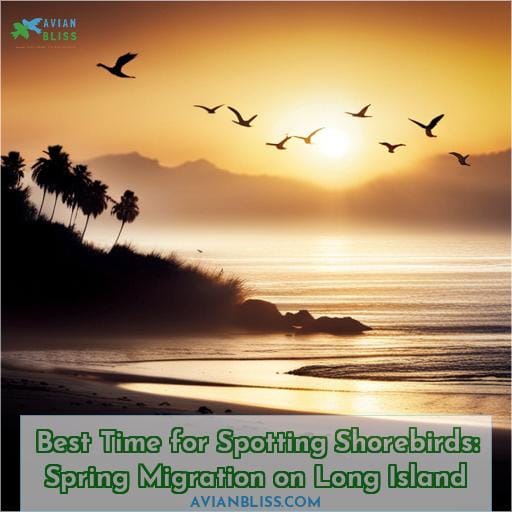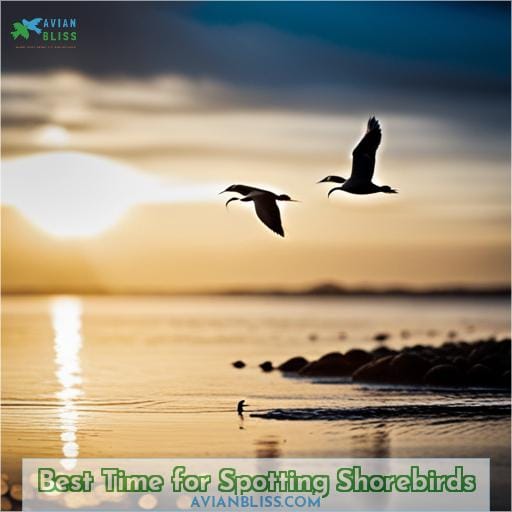This site is supported by our readers. We may earn a commission, at no cost to you, if you purchase through links.
 Ready to see shorebirds in their natural habitat? Spring migration on Long Island is the best time for spotting these awe-inspiring avians. From late March to early June, thousands of shorebirds make a stopover here and provide birders with plenty of opportunities for viewing.
Ready to see shorebirds in their natural habitat? Spring migration on Long Island is the best time for spotting these awe-inspiring avians. From late March to early June, thousands of shorebirds make a stopover here and provide birders with plenty of opportunities for viewing.
But before you get started, it’s important to understand the right equipment needed for your adventure: from binoculars or a budget scope all the way up to top-notch magnification. With just a little effort, you can contribute positively towards bird conservation during this amazing time of year—a testament both to nature’s beauty and humanity’s ability to work together when fascinated by something greater than themselves.
This understanding is epitomized perfectly through springtime shorebird watching on Long Island.
Table Of Contents
Key Takeaways
- Late March to early June is the prime time for spotting shorebirds on Long Island.
- Maintaining a 50-meter distance from flocks is important to avoid disturbance.
- High-quality optics such as spotting scopes and binoculars (10x magnification or higher) enhance the birdwatching experience.
- Learning to identify shorebird species by their size, shape, plumage, and behavior is essential for successful spotting.
Best Time for Spotting Shorebirds
Spotting banded shorebirds during spring migration offers a special birdwatching opportunity. From late March to early June, thousands of shorebirds stop on Long Island, New York, and reporting resightings of these banded birds provides researchers with valuable data about migration routes, behavior, habitats, and demographics to aid conservation efforts.
Spring Migration on Long Island, New York
You’re in for a treat this spring as thousands of magnificent shorebirds flock to the beaches of Long Island, offering ample opportunity to observe these awe-inspiring migrants up close through your trusty binoculars or spotting scope.
- Maintain a 50-meter distance from flocks to avoid disturbance.
- Observe band details: type, color, code, leg position.
- Record date, location, coordinates, flock size, photos.
- Report re-sightings to aid research and conservation.
The banded birds provide valuable data on behavior, demographics and habitat. Getting involved in shorebird conservation is encouraged during this centennial year of the Migratory Bird Treaty Act and the Year of the Bird.
Late March to Early June
Imagine the late April mornings spent scanning the beach through your spotting scope, glimpsing busy migratory shorebirds darting along the water’s edge before their northward journey.
The prime time to spot migrating shorebirds along the beaches of Long Island is late March through early June. This window provides ample opportunities to observe thousands of shorebirds, like red knots and semipalmated sandpipers, stopping to rest and feed during their migration along the Atlantic Flyway.
Having the right gear, like a quality spotting scope and tripod, will maximize your birdwatching experience and ability to identify distant flocks.
Thousands of Shorebirds
During spring migration on Long Island, New York, you can observe thousands of shorebirds from late March to early June. Some interesting statistics indicate that over 15,000 Red Knots alone stop over on Long Island during their migration along the Atlantic Flyway each year.
To identify the myriad shorebird species, bring quality optics like binoculars or spotting scopes. Learn techniques like scanning mudflats systematically. Note variations in size, shape, plumage, and behavior to aid identification.
Appreciate witnessing these epic migrations. Consider contributing data to research efforts that protect critical stopover habitats enabling these unfathomable journeys.
Banded Shorebirds and Research
Observing and reporting resightings of banded shorebirds provides invaluable data for research efforts into migration routes, population trends, and conservation needs. Detailed sighting records of banded individuals contribute to ongoing shorebird studies.
Time spent scanning flocks for bands aids scientific understanding of these migrants’ status and needs during this vulnerable yet fascinating stage of their annual cycle. Carefully noting band codes according to reporting protocols allows findings to become data points in tracking programs.
Reporting Re-sightings of Banded Birds
You’re absolutely crucial for migratory bird research if you promptly report any re-sightings of banded shorebirds.
- Record band type, color, code, and leg position.
- Note date, location, flock size, and coordinates.
- Take a photo if possible.
- Submit data to relevant organizations. Your vigilance enables vital migration research that supports shorebird conservation. With compassion and commitment, birdwatchers significantly contribute to scientific data collection.
Equipment Needed for Viewing Banded Shorebirds
Migrating shorebirds will soon be passing through Long Island, offering you a chance to spot banded birds that provide valuable data for research. To best view the small leg bands on distant flocks, you’ll need either a high-powered spotting scope mounted on a tripod or binoculars with at least 10x magnification.
Spotting Scope or Binoculars
Though documenting band details may seem daunting, don’t worry – with persistence and quality optics like a scope or binoculars, you’ll master reading bands in no time. For viewing distant flocks, a scope’s superior magnification reveals critical band data undetectable through regular binoculars.
However, binoculars offer adequate magnification for closer birds and provide greater portability during the peak migration observation windows. Carefully consider your needs, budget, and carrying capacity when selecting optics.
Maintaining Distance to Avoid Disturbance
Keep your distance to fifty meters from shorebird flocks so you don’t disturb them. Migrating shorebirds need to rest and feed without disruption. When observing, stay low and quiet. Excess disturbance can cause birds to abandon habitat. Responsible birdwatching means minimizing impact.
Give shorebirds space, and they’ll reward you with amazing sights. With care, we can all enjoy birds while supporting their survival.
Recording Banded Birds’ Details
Report the bands carefully, my friend; it is our moral duty. Look closely with binoculars or a scope; notice the band type, color, and code. Note the leg position too. Then record the date, place, and flock size. A photo is ideal.
Your data illuminates migratory paths and conservation needs for these remarkable shorebirds. Adhere to guidelines for minimal disturbance while reveling in the privilege of contributing to research on their mysterious journeys.
Reporting Banded Shorebirds
You need patience and persistence with binoculars to observe banded shorebirds during spring migration on Long Island.
- Report banded Piping Plover sightings to specific research projects.
- Submit American Oystercatcher re-sightings online at designated website.
- For other shorebirds, report bands at centralized database.
- Contribute to research and conservation by recording and reporting details.
Submitting re-sightings of banded birds provides crucial data for research projects working to understand and protect migratory shorebirds. Your participation helps map migration routes, monitor populations, and inform conservation efforts during this vulnerable part of their life cycle.
Though challenging, reporting bands is rewarding and makes a valuable contribution.
Opportunities for Bird Conservation During Migration
You have an exciting opportunity this year to become more involved with bird conservation during migration. The Migratory Bird Treaty Act just celebrated its 100th anniversary, so take advantage of the Year of the Bird initiatives to follow conservation efforts and find ways to help migrating birds that could use support after their long journeys.
The Migratory Bird Treaty Act
This year marks the centennial of the Migratory Bird Treaty Act; what a joy to celebrate a century-old law protecting the migration of shorebirds that will soon flock together along the coast. Let’s raise a glass to 100 years of international cooperation safeguarding migratory birds.
This pioneering legislation established a legal framework for conserving vulnerable species and their habitats across borders. Here’s to the next 100 years of partnerships preserving shorebirds, songbirds, waterfowl and more.
With dedication, we can achieve a future where urban wildlife thrives with human communities.
Getting Involved in Bird Conservation
Consider volunteering for bird banding projects during migration to get hands-on experience with conservation research.
- Participate in shorebird monitoring programs at key stopover sites.
- Assist with capturing, banding, and releasing migratory birds.
- Document and report re-sightings of banded birds.
- Attend birdwatching festivals to learn about conservation efforts.
- Contribute bird photos to online citizen science databases.
Getting involved in hands-on bird research and monitoring programs allows you to actively contribute to conservation initiatives protecting migratory shorebirds. The shared efforts of scientists and birdwatchers provide invaluable data to better understand and protect these remarkable migrators during their epic journeys.
The Year of the Bird
Experience migrating birds up close by volunteering for conservation efforts during the Year of the Bird. Explore conservation initiatives at local birding events and festivals. Assist with shorebird research projects or bird banding operations to learn about migration routes.
Purchase birding gear that supports conservation programs. Report banded bird sightings to track migrations along the Pacific Flyway.
Choosing the Right Scope for Birdwatching
When looking for optimal birdwatching equipment, consider both your budget and needs. While binoculars work for nearby birds, spotting scopes with superior magnification excel for distant shorebirds. Quality models start under $500, with mid-range options from $500-1500, and high-end scopes over $1500, so there are suitable choices at every budget level.
Scope Options for Every Budget
On Long Island, your binoculars deserve an upgrade if fall migration’s distant shorebirds stay a blur. Entry level scope options suit tight budgets, like the Celestron C90 or Barska 20-60×60. Affordable optics from Opticron, Vortex, and Nikon start under $300. Cost effective choices have simpler features but deliver bright, clear views of shorebirds.
Economical models still gather quality light for crisp images, just without extras. With research and realistic expectations, you can find a quality scope for any budget to observe fall migration’s shorebirds.
Binoculars for Nearby Birds
Binoculars let you see intricate details as birds draw near.
- Lightweight and compact models are easy to carry.
- Wide fields of view reveal more of the landscape.
- Even in low light, images stay bright and clear.
- Close focus capabilities capture birds at short range.
- Durable, waterproof builds withstand outdoor use.
- Try different models at your local birding shop before buying.
- Consider both budget and optical performance when choosing.
- Read binocular reviews in birding magazines for expert opinions.
- Comparison shop online to find the best deals.
- Investing in quality optics will reward you for years.
Spotting Scopes With Superior Magnification
Consider investing in a spotting scope to clearly view distant shorebirds during fall migration. High magnification scopes mounted on sturdy tripods enhance visibility, allowing improved bird identification from afar.
Opt for an angled or straight scope based on your preference. Prioritize quality optics providing crisp, bright images to discern fine details on shorebirds. Test models in person when feasible. Quality spotting scopes magnify distant flocks, aiding your shorebird studies during peak migration.
Factors to Consider When Choosing a Scope
As you gaze across the marsh, an osprey hovers in the distance before diving for its prey—a sign that fall migration is underway. You’ll need a quality spotting scope to get a closer look at such scenes. When selecting a scope, consider magnification power, stability from a sturdy tripod, and optical quality like brightness and sharpness.
Also take into account budget constraints. Quality scopes provide sharp details but can be expensive. Test models to find the right balance of features for your birding needs and budget.
Testing Multiple Models at Birding Stores or Festivals
Testing different spotting scope models in person at birding outlets allows you to experience their optics quality firsthand.
- Evaluate sharpness on distant targets
- Assess brightness across the field of view
- Check ease of focus ring adjustment
- Compare image stability on tripods
- Consider portability of different models
When scope shopping, visiting specialty birding stores and festivals provides hands-on testing to judge optical performance. Comparing models side-by-side can inform your criteria and identify the optimal scope for your needs and budget.
Thoughtful evaluation and field testing yield the greatest long-term satisfaction.
Conclusion
When it comes to spotting shorebirds, timing is everything. On Long Island, New York, late March to early June marks the peak of migration and the best time for shorebird spotting. With the right equipment and a keen eye, you can get involved in conservation efforts for these birds.
Whether you choose to use a spotting scope or binoculars, you’ll be able to observe the birds in great detail.
But choosing the right scope for birdwatching can be tricky. With so many options available, you’ll need to consider your budget and research to find the best one for you. Whichever you decide, the experience of watching shorebirds in their natural habitat is sure to be rewarding.







